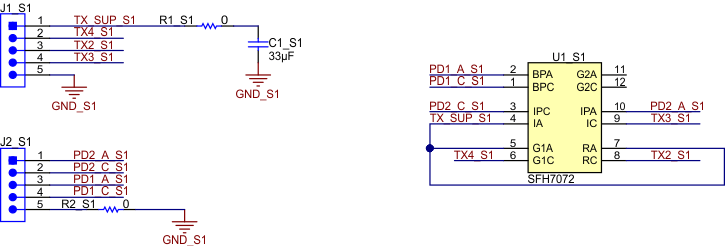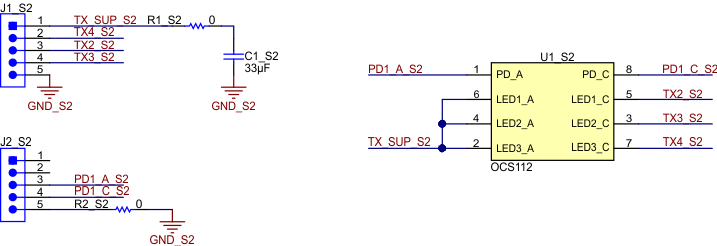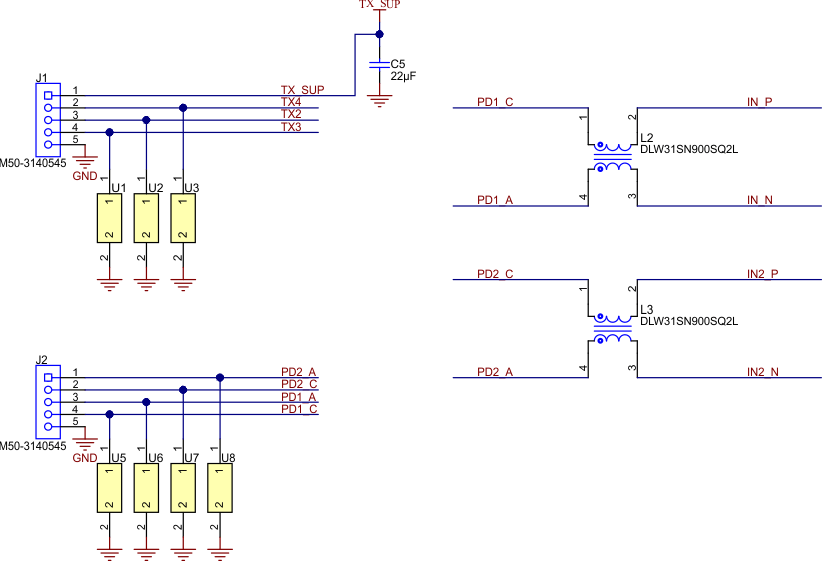TIDUDO6B May 2019 – October 2020
- Description
- Resources
- Features
- Applications
- 5
- 1System Description
-
2System Overview
- 2.1 Block Diagram
- 2.2 Highlighted Products
- 2.3
System Design Theory and Design Considerations
- 2.3.1 AFE4900 and Power Supply
- 2.3.2 CC2640R2F Microcontroller
- 2.3.3 PPG Measurement
- 2.3.4 ECG Measurement
- 2.3.5 Selecting TX Supply (TX_SUP) Value for Driving LEDs
- 2.3.6 Generating TX Supply for Driving LEDs
- 2.3.7 Generating RX Supply for AFE4900
- 2.3.8 Generating I/O Supply
- 2.3.9 Battery Input and Reservoir Capacitors
- 2.3.10 Battery Life Calculations
- 2.3.11 External Memory
- 2.3.12 LED Indications
- 2.3.13 Connections Between Sensor Board and ECG Board
-
3Hardware, Software, Testing Requirements, and Test Results
- 3.1 Required Hardware and Software
- 3.2 Testing and Results
-
4Design Files
- 4.1 Schematics
- 4.2 Bill of Materials
- 4.3
PCB Layout Recommendations
- 4.3.1 Layout for Main Board
- 4.3.2 Connection From PDs to AFE
- 4.3.3 Connections From LEDs to AFE
- 4.3.4 Connections From ECG PADs to AFE
- 4.3.5 Connections Between BT and AFE
- 4.3.6 Connections Between BT Antenna and Chip
- 4.3.7 Boost Converter
- 4.3.8 Buck-Boost Converter
- 4.3.9 Layouts for PPG Sensor Boards
- 4.3.10 Layout for ECG Sensor Board
- 4.3.11 Layout Prints
- 4.4 Altium Project
- 4.5 Gerber Files
- 4.6 Assembly Drawings
- 5Software Files
- 6Related Documentation
- 7About the Authors
- Revision History
2.3.3 PPG Measurement
For PPG measurement, three LEDs and two PDs are used in a single package. Table 2-2 lists details about the OCS112 (from Taiwan Biophotonic Co.) and SFH7072 (from OSRAM®).
| SENSOR | OCS112 | SFH7072 |
|---|---|---|
| Number of LEDs | 3 | 4 |
| Number of PDs | 1 | 2 |
| LED1 color | Red | Green |
| LED1 wavelength | 655 nm | 526 nm |
| LED2 color | IR | Green |
| LED2 wavelength | 945 nm | 526 nm |
| LED3 color | Green | Red |
| LED3 wavelength | 525 nm | 660 nm |
| LED4 color | – | IR |
| LED3 wavelength | – | 950 nm |
| LED1 VF (typ) | 2.1 | 1.3 |
| LED1 VF (max) | 2.4 | 1.8 |
| LED2 VF (typ) | 1.4 | 2.1 |
| LED2 VF (max) | 1.55 | 2.8 |
| LED3 VF (typ) | 3.2 | 3 |
| LED3 VF (max) | 3.7 | 3.4 |
| LED4 VF (typ) | – | 3 |
| LED4 VF (max) | – | 3.4 |
The Sensor boards are designed to fit on the main board with 5-pin connectors, based on the LEDs and PDs available in the Optical Sensor. All the LEDs are configured in push-pull (common anode mode). See Figure 2-6 and Figure 2-7 for the connection diagrams.
 Figure 2-6 Sensor Board Schematic With SFH7072 Device
Figure 2-6 Sensor Board Schematic With SFH7072 Device Figure 2-7 Sensor Board Schematic With OCS112 Device
Figure 2-7 Sensor Board Schematic With OCS112 DeviceThe Sensor boards are fit onto the main board using the J1 and J2 connector, as shown in Figure 2-8.
 Figure 2-8 PPG Connection From Sensor Board to AFE4900 Device on Main Board
Figure 2-8 PPG Connection From Sensor Board to AFE4900 Device on Main BoardThe J1 connector has 5 connections: TX_SUP, TX drive pins, and GND. The J2 connector has 5 connections: PD1 Anode and Cathode, PD2 Anode and Cathode, and GND. The connector inputs are protected using ESD diodes (TPD1E10B06DPYR) from Texas Instruments. The TPD1E10B06 device is a single-channel, ESD, TVS diode in a small 0402 package. This TVS protection product offers ±30-kV contact ESD, ±30-kV IEC air-gap protection, and an ESD clamp circuit with a back-to-back TVS diode for bipolar or bidirectional signal support. The TX_SUP pin is decoupled using a 33-µF capacitor.
The PD signals are filtered using SMD Common Mode Chokes (having specifications as 90 Ω at 100 MHz, 370-mA DCR 300 mΩ). The chokes help in improving the immunity to external common mode noise signals and improve overall SNR of the system.